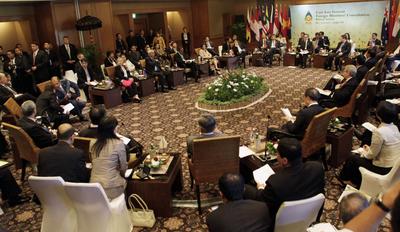Generally, East Asian regional financial cooperation has shown greater progress in ASEAN+3 with the Chiang Mai Initiative Multilateralisation (CMIM) and Asian Bond Market Initiative (ABMI). In addition, ASEAN has been intensively negotiating various financial cooperation projects among member states to achieve the 2015 target of an ASEAN Economic Community (AEC). Globally too, financial cooperation has significantly increased as evinced by the progress of international financial-institution reform as well as financial-governance restructuring in the G20 member countries. But what role does the EAS financial cooperation play in all this?
It could be said that EAS financial cooperation has created less progressive outcomes. Last year’s informal finance ministers’ meeting in Tashkent proved that the forum has become little more than a medium for consultation regarding economic growth in East Asia. Although there was a capacity-building program related to securities market supervisory agencies for several members, the program seemed to have little impact. In addition, Australia’s idea to establish an EAS Trade Finance Network has also lacked support from other members.
Given the current circumstances, there are several issues that might be beneficial to consider for the future of EAS Financial Cooperation.
First is the focus of interest. Until last year, there was no clear common interest among EAS finance officials toward particular issues to be explored. The issue of economic growth discussed last year was too general and has already been canvassed in many other forums. EAS financial cooperation should come up with a common concern like trade liberalisation in APEC or the regional pooling fund in ASEAN+3. A common interest will allow member countries to discuss concrete solutions to the problems faced in the region.
Second is leadership. We may consider this issue best by reflecting on the ASEAN+3 financial cooperation where Japan effectively takes the lead in initiating many programs. Although ASEAN claims the so-called ‘driver’s seat’, there is no doubt that Japan plays a dominant role in creating the majority of the programs in ASEAN+3. Japan is therefore somewhat like Germany in the EU, willing to provide most of the monetary assistance in order to achieve the region’s collective objectives. Put simply, the contested leadership issue is important as it keeps the forum ‘busy’ with new initiatives and renditions of support. But the leadership seat is in effect still vacant and needs to be resolved soon.
Australia can contribute to cooperation on leadership issues by bringing in back-up to both Japan and the US. The current geo-political situation and Australia’s sound economic condition certainly will support Australia to play a leading role. However, Canberra needs to work hard to seize this opportunity, especially in order to gain support from major Asian powers, especially China and Japan. The rejection by major Asian powers of Australia’s initial proposal to join the CMIM indicates that Canberra needs to put in more work if it wants to lead the EAS in this area.
Third is the type of framework. If EAS financial cooperation expects a concrete outcome in the near future, a formal framework is the best bet. A formal framework will shape cooperation in a systematic process that is manageable in terms of agenda, and predictable in terms of progress and output. But shaping a formal framework for EAS financial cooperation is not an easy task as many in Asia still prefer an informal structure. The 2010 informal finance ministers’ meeting for example reveals that, even in the financial realm, informality is still the favoured option. But while informality is useful to develop flexible cooperation, it also means that there will be no binding agenda.
In addition, the presence of the US and Russia as new EAS members will not immediately affect the status of EAS financial cooperation. The US is still reeling from domestic financial problems in the wake of the global financial crisis, and the more recent domestic political kerfuffle over raising the debt ceiling, which may inhibit its involvement in direct financial cooperation with the East Asian region. Russia is only a peripheral player in the region unlikely to seize leadership at this stage and has only limited financial interaction and cooperation with the rest of the EAS countries in any case. Therefore, the short-term future of EAS financial cooperation will be predominantly determined by Asian major powers and only secondly by the ASEAN states as a collective bloc. It is in the hands of the Asian major powers to decide whether EAS financial cooperation will transform into a more concrete regional forum or remain a consultative medium.
Eko NM Saputro is a PhD Student at the School of International and Political Studies, Deakin University, Melbourne.

